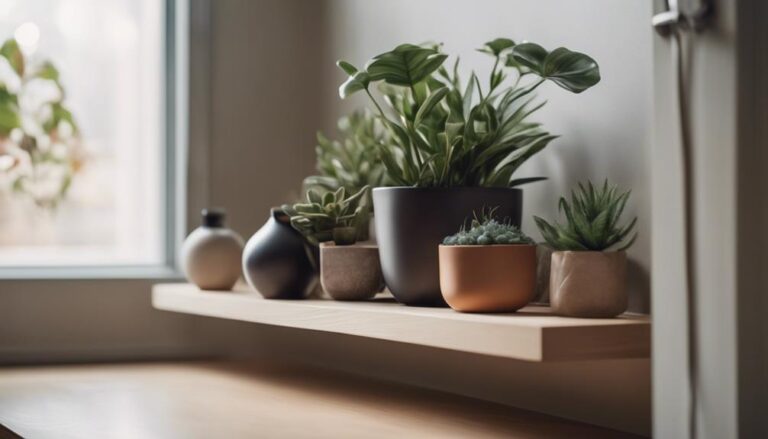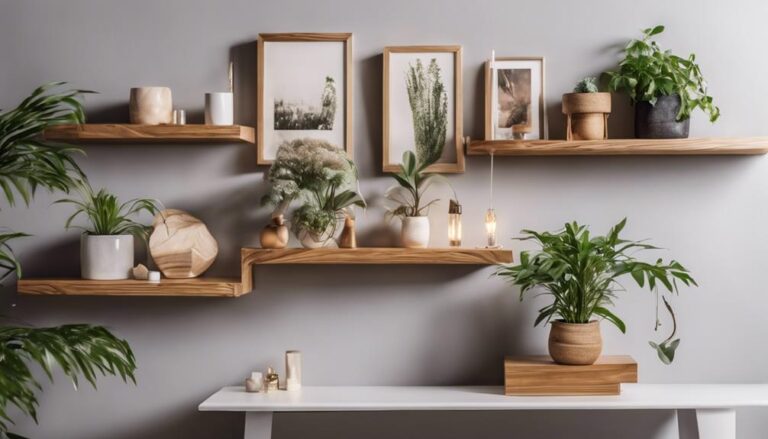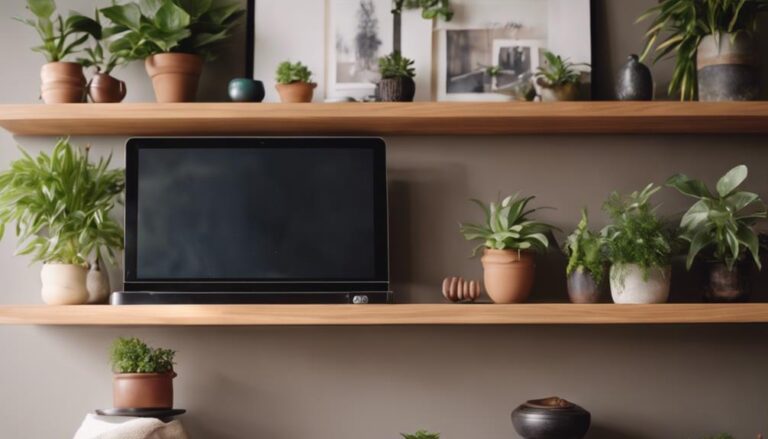Key Considerations for Location Selection When Installing a Floating Wood Shelf

When setting up a floating wood shelf, it's crucial to assess the wall construction and anchoring to create a sturdy base. Understanding the weight capacity and load-bearing abilities of the wall is essential in order to avoid any potential collapses.
Additionally, ensuring that the shelf complements the surrounding decor for a cohesive and visually appealing look is key. Strategic placement and efficient use of space can optimize functionality and aesthetic harmony with existing furniture.
Considering factors like lighting, moisture levels, and climate conditions is important for the long-term durability and maintenance of the shelf. Adhering to building codes and safety regulations is a must to guarantee a secure installation.
By delving into these key considerations, you can install a floating wood shelf that not only meets your needs but also enhances the overall design of the space.
Key Takeaways
- Before mounting your floating wood shelf, it's crucial to understand the wall construction. This knowledge will help you choose the right anchoring methods for a secure and stable foundation.
- Make sure to check the weight capacity of both the wall and the items you plan to place on the shelf. It's essential not to exceed the maximum load-bearing limit to prevent any accidents.
- When selecting the location for your floating wood shelf, consider how it fits into the room's overall aesthetic. Choose a spot that complements the decor and enhances the visual appeal of the space.
- Position the shelf in a convenient and easily accessible area. Think about ergonomics and user experience, placing it within reach and not obstructing high-traffic areas.
- Lastly, evaluate the environmental conditions of the room. Consider factors like moisture levels and climate to ensure the long-term durability and proper maintenance of your floating wood shelf.
Wall Construction and Anchoring
Before we start setting up our floating wood shelf, it's crucial to determine if the wall's construction can support it securely. To ensure a stable installation, we'll begin by using a stud finder to locate the wall studs for proper anchoring. By identifying these structural supports, we can guarantee that our shelf will be firmly attached to the wall.
The type of wall material, whether it's drywall, plaster, or another material, will dictate the appropriate anchoring methods for optimal support. For hollow walls, we'll reinforce the area to prevent any potential instability of the shelf. By carefully assessing the wall construction, we can select the right anchoring technique to provide a solid foundation for our floating shelf.
When it comes to choosing the right anchors or screws, it's essential to consider the composition of the wall. Drywall typically requires specialized wall anchors, while wood studs allow for screws to be directly inserted into the framing for a secure hold. In the case of plaster walls, toggle bolts or molly anchors may be necessary to ensure a sturdy installation.
Selecting the appropriate fasteners based on the wall material will play a key role in giving our floating wood shelf the support it needs to function effectively.
Weight Capacity and Load Bearing
When installing a floating wood shelf, it's crucial to consider the weight capacity required based on the items you plan to put on it. You must also take into account the load-bearing capacity of the wall where the shelf will be mounted to ensure that the shelf brackets and hardware can safely support the expected weight without compromising safety. It's important to distribute the weight evenly across the shelf to prevent exceeding its maximum weight limit.
Before deciding on the placement of your floating wood shelf, carefully review the manufacturer's guidelines to determine the maximum weight the shelf can withstand. This will help you choose the right location for installation and decide what items can be displayed safely.
Aesthetic Appeal and Visual Harmony
When installing a floating wood shelf, it's essential to go beyond just considering weight capacity and load-bearing capabilities. The aesthetic appeal and visual harmony that the shelf brings to a space are equally important. By choosing a shelf that complements the existing décor and architectural style, you can create a cohesive and visually appealing design.
When deciding on the location for your floating wood shelf, there are several factors to consider to enhance its aesthetic appeal:
- Color & Finish: Ensure that the color and finish of the wood shelf match or complement the surrounding décor for a seamless look.
- Room Style: Take into account the overall style of the room, whether it's modern, rustic, or minimalist, and choose a floating shelf that aligns with that aesthetic.
- Wall Texture: Consider the color and texture of the wall where the shelf will be installed to enhance its visual impact.
- Size & Shape: Opt for a shelf size and shape that creates a balanced and visually pleasing arrangement in the space.
- Lighting: Incorporate proper lighting around the floating wood shelf to highlight its natural beauty and create a welcoming atmosphere.
Functional Placement and Space Utilization
When installing a floating wood shelf, the key consideration is how to optimize its functionality and space utilization within the room. Careful planning and thoughtful placement are crucial to ensure that the shelf not only serves its purpose effectively but also blends seamlessly with the overall aesthetic of the space.
By strategically positioning the shelf, we can maximize its efficiency without compromising the visual harmony of the room.
To achieve the best results, it's essential to select the location for the floating wood shelf based on both practicality and design considerations. The chosen spot shouldn't only offer easy access to the items placed on the shelf but also complement the existing decor and layout of the room.
By integrating the shelf into the room's design scheme, we can create a cohesive and visually appealing space that's both functional and stylish.
Maximizing Efficiency
For optimal efficiency when installing floating wood shelves, it's key to strategically position them near where they'll be most frequently used. This ensures easy access and functionality within the space.
By carefully assessing the shelf's weight capacity, depth, and the overall storage area available, we can make the most of the vertical space. Placing shelves in high-traffic areas where items are regularly needed allows for smoother workflows and increased productivity.
Utilizing the vertical wall space by installing floating wood shelves helps maximize storage without taking up precious floor space. Organizing items on the shelves in an aesthetically pleasing and orderly manner can enhance the overall look of the room, seamlessly blending functionality with design.
Integrating Aesthetics
When installing a floating wood shelf, it's not just about efficiency; we need to think about how it will enhance the look of the space. The placement of the shelf can greatly impact the functionality and visual appeal of the room.
When deciding where to place a floating wood shelf, it's important to consider how it will blend in with the existing decor. Here are some factors to think about to ensure a seamless integration:
- Aesthetic Appeal: Make sure the shelf complements the style, colors, and textures of the room.
- Functionality: Think about how the shelf can improve the usability and flow of the space.
- Storage Options: Consider how you can make the most of the shelf for displaying and organizing items.
- Space Utilization: Optimize the positioning of the shelf for the greatest impact.
Alignment With Surrounding Furnishings
Ensuring that the floating wood shelf aligns with the surrounding furnishings is crucial for creating a cohesive and visually appealing space. The style, color, and design aesthetics of the existing furniture must be carefully considered to ensure that the shelf seamlessly blends in with the room's overall look.
Coordinating the placement of the shelf with other decor elements is essential for achieving a harmonious and balanced atmosphere. By strategically choosing a location that complements the surrounding furnishings, we can enhance the overall visual impact of the space.
Consistency in material choice and finish is key to establishing a unified and harmonious environment. The selected location shouldn't only match the existing furniture but also enhance the room's theme and ambiance.
Paying attention to the alignment between the floating wood shelf and the surrounding furnishings will help us create a cohesive and visually stunning design that enhances the overall aesthetic appeal of the space.
Accessibility and Ease of Use
When choosing where to install your floating wood shelf, it's essential to prioritize accessibility and ease of use. Opt for a height that allows for effortless reaching and placing items on the shelf, ensuring a smooth and user-friendly experience.
Also, make sure to steer clear of placing the shelf in areas with high foot traffic to prevent hindering movement and maintain the room's functionality.
Optimal Placement for Convenience
Placing the floating wood shelf at eye level ensures easy access to commonly used items, promoting convenience and reducing strain. It's advisable to position the shelf near workspaces or areas where items are frequently needed, optimizing its placement for practicality.
By strategically placing the shelf in a well-lit area, you can improve visibility and functionality, making it easier to locate and retrieve necessary items promptly.
To prevent physical discomfort when accessing the shelf, it's essential to avoid placing it too high or too low. Instead, aim for a location that allows for easy reach, seamlessly integrating the shelf into your daily routines.
This thoughtful approach to shelf placement will enhance overall convenience and usability, enabling you to fully utilize the benefits of the floating wood shelf in your workspace or living area.
Ergonomics and User Experience
Considering ergonomics and user experience is crucial when choosing where to install a floating wooden shelf. Prioritizing accessibility and ease of use ensures that the shelf fits seamlessly into daily routines and functions optimally.
When deciding on placement, it's important to think about the height and reach needed to comfortably reach items on the shelf. Opting for a location that reduces the need for bending or stretching not only improves ergonomics but also enhances the overall user experience. Installing the shelf at a height that allows for easy viewing and retrieval of items is key to increasing convenience and accessibility.
Moreover, selecting a location that complements the room's layout and enhances the user's experience is essential. By considering these aspects, we can create a floating wooden shelf that isn't only visually appealing but also highly practical, resulting in a superior user experience overall.
Proximity to High-Traffic Areas
Placing a floating wood shelf near high-traffic areas such as entryways or kitchens ensures easy access for everyday use. Understanding the importance of positioning the shelf in these bustling zones enhances its functionality in busy spaces. Accessibility plays a crucial role in determining the ideal location to maximize the shelf's usability.
By positioning the shelf within arm's reach, we guarantee its convenience in daily routines. This strategic placement strikes a balance between accessibility and aesthetics, creating a harmonious and functional space. Whether storing frequently used items or showcasing decorative accents, the shelf's strategic location near high-traffic areas ensures it becomes a go-to solution for your household needs.
Careful consideration of the shelf's proximity to high-traffic zones is a vital aspect of the location selection process. Prioritizing accessibility allows us to unlock the full potential of this versatile storage solution, seamlessly integrating it into the flow of your busy lifestyle.
Lighting and Ambiance Considerations
When deciding where to place the floating wood shelf, it's essential to choose a well-lit spot that can highlight its natural beauty and texture. Opting for a location with ample ambient lighting will enhance the shelf's appearance and create a cozy and welcoming atmosphere in the room. It's also important to avoid direct sunlight, as prolonged exposure can lead to discoloration and warping of the wood over time.
To add a modern and innovative touch, consider incorporating LED lighting strips or puck lights to showcase the shelf. These energy-efficient options not only provide a sleek look but also offer the flexibility of adjusting the ambiance with dimmable lighting settings.
By integrating these different lighting choices, you can customize the mood of the space to fit your preferences, whether you prefer a snug and intimate setting or a bright and lively one.
Moisture and Climate Factors
When picking the perfect spot for a floating wooden shelf, it's crucial to take into account how humidity levels and temperature changes can affect it.
Areas with high moisture, such as bathrooms, can cause the wood to warp or suffer damage if left unprotected. To prevent this, it's important to seal the shelves properly.
Moreover, extreme fluctuations in climate can result in the wood expanding or contracting, which may weaken the shelf's integrity over time. So, it's essential to consider these factors when deciding where to install your floating wood shelf.
Humidity Levels Impact
When choosing a spot to install a floating wood shelf, it's crucial to consider the humidity levels and climate conditions of the area. High humidity can spell trouble for your wood shelf, leading to warping, cracking, and even rotting. Excess moisture in the air can also create the perfect environment for mold and mildew to thrive.
Temperature changes can further impact the stability and overall condition of your floating wood shelf, as wood is quite sensitive to fluctuations in humidity, expanding and contracting accordingly.
To safeguard the durability of your wooden floating shelves, adequate ventilation and moisture management are key, especially in regions with varying climates. By carefully evaluating the humidity levels and climate factors of the installation site, you can ensure that your floating wood shelves maintain their pristine state for many years ahead.
With the right precautions in place, you can sidestep the expensive repairs or replacements that may arise from humidity-related issues.
Temperature Fluctuations Influence
Temperature fluctuations play a critical role in the stability and durability of floating wood shelves. Wood, being a porous material, is sensitive to changes in temperature and humidity. When exposed to fluctuations, wood tends to expand and contract, which can result in warping, cracking, or even structural damage if not managed properly. Therefore, it's essential to take into account the temperature variations in the room where you plan to install your floating wood shelf.
Extreme temperature changes can significantly impact the integrity of the wood shelf over time. It's advisable to avoid placing the shelf near heat sources like radiators or fireplaces, as the excessive heat can accelerate the detrimental effects on the wood. Additionally, sudden temperature shifts, common in poorly insulated rooms, can also pose a risk to the long-term performance of your floating wood shelf.
Selecting a suitable location for your floating wood shelf is crucial to ensure its longevity and stability. By considering the temperature fluctuations in the space and avoiding exposure to extreme heat sources, you can help maintain the integrity of the wood and prevent potential damage.
Long-term Durability and Maintenance
To ensure the long-term durability and maintenance of your floating wood shelf, it's crucial to pick a suitable location that avoids direct sunlight and high-moisture areas. Exposure to sunlight can lead to discoloration and warping, while excess humidity may cause wood rot and deterioration. These factors are key in preserving the stability and lifespan of your shelf.
When selecting a location for your floating wood shelf, consider the weight of items that will be placed on it. Choosing a sturdy spot that can support the total weight load will help maintain the long-term stability of your setup. Regular dusting and cleaning are also important to preserve the shelf's appearance and prevent the accumulation of dirt and grime.
To enhance the shelf's resistance to scratches, stains, and other damage, it's recommended to apply a protective finish or sealant. This additional step will protect your investment and ensure that your floating wood shelf remains in top condition for years to come.
Building Codes and Safety Regulations
When installing a floating wood shelf, it's crucial to adhere to building codes and safety regulations that govern its placement and weight-bearing capacity. These guidelines ensure the shelf is securely attached and help prevent accidents.
To meet these standards, it's important to consider the following regulations:
Regulation: Minimum Distance from Electrical Fixtures
Requirement: The shelf must be a specified distance away from outlets, switches, and other fixtures.
Verification: Measure the distance and compare it to local building codes to ensure compliance.
Regulation: Weight Capacity
Requirement: The shelf must support a minimum weight to prevent collapse.
Verification: Consult the manufacturer's specifications and local safety regulations to determine the appropriate weight capacity.
Regulation: Anchor Type and Placement
Requirement: Specific anchors and hardware are necessary for secure shelf attachment.
Verification: Carefully follow the installation instructions and local building regulations to ensure proper anchor type and placement.
Frequently Asked Questions
How Do You Know Where to Put Floating Shelves?
When deciding where to install our floating wood shelves, we should take into account factors like the dimensions of the shelf, its weight capacity, and the overall aesthetic we want to achieve. Considering the size of the shelf is essential to ensure it fits well in the chosen location without looking too small or overpowering the space.
Moreover, understanding the weight capacity of the shelf is crucial to prevent any accidents or damage to the wall. By following the manufacturer's guidelines and using appropriate mounting hardware, we can ensure the shelf is safely secured to the wall.
In addition to size and weight capacity, we should also consider the visual appeal of the shelves. Placing them in areas where they complement the existing decor or serve as a focal point can enhance the overall look of the room.
Accessibility is another key factor to keep in mind when determining the placement of floating shelves. Placing them at a height that is easy to reach and use will make them more functional and practical for storing and displaying items.
Lastly, considering any lighting needs in the chosen locations can further enhance the display on the shelves. Placing them near natural light sources or adding additional lighting can highlight the items on the shelves and create a visually stunning effect.
What Do I Need to Know Before Installing Floating Shelves?
When setting up floating wood shelves, it's essential to consider factors like the shelf's weight capacity, the material of the wall surface, the required size, the tools needed for installation, the visual appeal, and the maintenance requirements. By carefully evaluating these aspects, we can choose the perfect spot and create a sturdy and attractive storage solution.
When selecting the location for your floating wood shelves, think about the weight capacity of the shelf and the items you plan to place on it. Make sure the wall surface can support the weight and consider using wall anchors for added stability if needed. It's also important to measure the space accurately to ensure the shelf fits well and complements the room's layout.
Additionally, take into account the aesthetic aspect of the shelves. Choose a location that enhances the overall look of the room and consider the style and finish of the wood shelves to ensure they blend seamlessly with the existing decor. This will create a cohesive and visually pleasing display that adds character to the space.
Lastly, think about the maintenance needs of the floating wood shelves when selecting the location. Consider factors like exposure to sunlight, moisture levels, and ease of cleaning to ensure the shelves remain in good condition over time. By considering these aspects, you can set up your floating wood shelves in the perfect location for both functionality and aesthetics.
What Is the Rule of Thumb for Floating Shelves?
When it comes to hanging floating shelves, experts suggest mounting them at a height of 66 inches from the floor. This specific placement is recommended to ensure optimal stability, weight capacity, hardware efficiency, visual appeal, and utilization of space. By positioning the shelves at eye level, you can create a stylish and functional display that enhances the overall aesthetic of the room.
This standard height for floating shelves is based on a combination of factors that contribute to a successful installation. Placing the shelves at 66 inches from the floor not only offers a balanced and visually pleasing arrangement but also makes it easier to access the items on the shelves. Additionally, this height takes into account the average eye level of most individuals, ensuring that the items displayed on the shelves are easily visible and within reach.
What Is the Best Placement for a Shelf?
We will install the floating wood shelf at eye level to ensure easy access and a visually pleasing display. By spacing it to harmonize with the room's decor, we can create a balanced and stylish look. The shelf will be securely mounted on a robust wall to support its weight capacity, guaranteeing both stability and aesthetic appeal.
When determining the location for the shelf, it is essential to consider both functionality and design. Placing it at eye level not only makes it convenient to reach items but also creates a focal point in the room. This positioning allows for effortless organization and showcases the shelf's contents effectively.
Furthermore, mounting the shelf on a sturdy wall ensures its longevity and safety. By taking into account the load capacity of the wall, we can prevent any potential accidents or damage. This careful consideration of both practicality and aesthetics results in a well-balanced and visually pleasing installation that enhances the overall look of the room.
Conclusion
When choosing the perfect spot for your floating wood shelf, it's crucial to consider a range of factors that contribute to its overall success. From ensuring secure wall anchoring to maximizing both functionality and aesthetics, every aspect plays a pivotal role in achieving the desired outcome.
By taking a holistic approach and carefully weighing all elements, you can create a solution that not only withstands the test of time but also elevates the overall design of the space. In essence, thoughtful planning is the cornerstone of a floating shelf that truly excels in both form and function.





